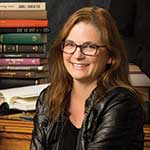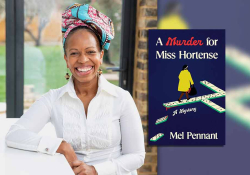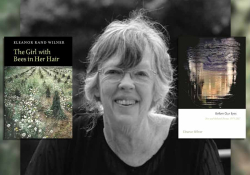Finding Refuge and Inspiration in the “City of Bridges”: A Conversation with Tuhin Das

Tuhin Das is a Bengali poet, essayist, activist, and short-story writer. Currently a writer-in-residence of City of Asylum Pittsburgh, he recently completed his Comma House, part of CAP’s commissioned murals project, House Publications, a library of houses featuring text-based artwork on their façades. The houses are located on Sampsonia Way, in Pittsburgh’s Northside.
Here Das speaks with WLT’s managing and culture editor about leaving Bangladesh, where he finds inspiration in Pittsburgh, why he chose to shape his poem like a comma, and more.
Michelle Johnson: You’re writer-in-residence at City of Asylum in Pittsburgh. Can you tell us how you came to be in Pittsburgh?
Tuhin Das: Growing up in Barishal, in the southern part of Bangladesh, I never imagined I would live in the city of bridges surrounded by three rivers, pierogi lovers, and Steelers, Pirates, and Penguins fans. When I was a teenager, I enjoyed writing and editing, and at times wrote about religious rights and the persecution of minorities in Bangladesh. As a consequence, I was targeted because of my writing and activism by the Bangladeshi Islamist groups who limit freedom of expression. Between 2013 and 2018, there was a killing spree in Bangladesh targeting dozens of secular writers and activists who opposed the political mission of Islamists. The local outfits of notorious organizations, such as Al-Qaeda in the Indian Subcontinent (aqis) and ISIS, were the main culprits behind these murders.
In 2015 I found my name on a hit list and felt my safety was at risk. I applied for a long-term writer sanctuary program through the organization called International Cities of Refuge Network (icorn) based in Norway. My case was investigated by the UK-based PEN International, and my application was forwarded to City of Asylum Pittsburgh. In 2016 I came to Pittsburgh as a visiting scholar at Carnegie Mellon University and became a writer-in-residence at City of Asylum. In the past six years I have been unable to return home to my family and friends. After years of waiting, in November 2021 I was granted asylum by the US government.
Johnson: I’ve spent a few days in Pittsburgh and am eager to return. It’s a fascinating city with its Three Sisters bridges, the Warhol Museum, and the August Wilson African American Cultural Center. Where do you find inspiration in Pittsburgh?
I stood on the bridge named after Warhol and felt inspired thinking about my art and my purpose for coming to Pittsburgh to rebuild my life.
Das: I am inspired by the works of artists, writers, and musicians, and am thankful they are cultivated and thriving in Pittsburgh. I knew about Andy Warhol before coming to the US and was enchanted by his social commentary through art and use of pop art, so I was excited to learn he lived in Pittsburgh and to see his influence here. When I first arrived and walked along the Allegheny River, I stood on the bridge named after him and felt inspired thinking about my art and my purpose for coming to Pittsburgh to rebuild my life. I admired the fact that a significant bridge was named after an artist, since bridges are named after politicians in my home country.
As I explored the city more, I noticed throughout there are a lot of murals on the old, red-brick buildings and riverbank walls. In daily life, I get inspiration from these artworks, such as the “Black Lives Matter” local artists painted after George Floyd’s murder. I think it is amazing that Gandhi is recognized through Adelaide Cole’s mural on Murray Avenue in Squirrel Hill, as his nonviolent movement still has impact outside the Indian subcontinent and is a reminder to pursue a path of peace all around the world. I go to the art venues—the Mattress Factory (yes, that’s the name of a museum in Pittsburgh), Three Rivers Arts Festival, Lawrenceville Art Crawl, Gallery Crawl in the Cultural District, and the Carnegie Museum of Art—and see the artwork of contemporary artists. I get inspiration from them.

One of my favorite sculptures in the city is of Native American Seneca leader Guyasuta facing George Washington. Located in Point of View Park overlooking the Pittsburgh skyline, it showcases where they met in 1770 at the confluence of the Monongahela and Allegheny rivers, when there was likely tension regarding the white settlers violating the Proclamation of 1763 that restricted white settlement west of the Alleghenies. I see this sculpture as emphasizing the importance of history and respect for those we live beside, even when we are on opposing sides and have conflict.
I go to literary events, especially those given by immigrant writers. I like hearing the writers talk about the behind-the-scenes of how they make their art and how they navigated their new lives in America. I get inspired by them. I love jazz and blues music, and am grateful Pittsburgh is a haven for its jazz culture. I feel I need more music in my life and enjoy listening to WZUM and at venues like Con Alma, City of Asylum, and Genuine Pub.
I love jazz and blues music, and am grateful Pittsburgh is a haven for its jazz culture.
Johnson: When I return, I want to visit Sampsonia Way, where the City of Asylum website talks about a public library of “published” houses that people can view while walking down the street. I’ve never experienced anything like this. Can you describe it?
Das: During the past fifteen years, Sampsonia Way has not only become a shelter for exiled writers and artists from around the world but has also blossomed into a physical expression of their works. It is located a few blocks from Alphabet City (the name for the main building of City of Asylum, as it displays the handwritten languages of its visiting artists and writers), so it is very convenient for the artists and writers to feel connected to the cultural center’s activities and events. Along Sampsonia Way, there are five houses with artwork on their façades. Over the years, different exiled writers have lived in these houses.
Though they are from different countries, the exiled writers and artists have experienced rejection and persecution by their home countries and societies, so living in close proximity provides a sense of protection and sanctuary from what they have escaped. While living on Sampsonia Way, they rebuild their lives in the US. Basically, the houses on Sampsonia Way become their base stations and safe spaces for creating new ideas. Their new concepts and works may not be allowed to be published in their home country. It can take a few years as they navigate the complexities of the US immigration system, and when they achieve their immigration goals, the artists and writers then depart from this alley and immerse themselves in the diverse American society, so that a new exiled writer can then take their place and move in.
City of Asylum commissions murals called House Publications. For example, one house was painted by a Chinese poet, Huang Xiang, and his house is encased in Chinese calligraphy. By that, visitors to Sampsonia Way can learn about the artists and writers who have safely resided on this street in the last fifteen years, which is amazing. This street is not just recognized as the home of rejected writers but more so a vibrant and expressive alley through which the artists can share their experiences and brighten the narrow lanes in the neighborhood.
Johnson: Are you aware of other projects like this?
Das: No, I am not aware of any other “house publications,” such as what City of Asylum has crafted on Sampsonia Way. Huang Xiang, when he was an exiled writer in Pittsburgh, wanted to carve his poems on the sides of the mountains around Pittsburgh, but City of Asylum encouraged him to paint on the outside of his house instead. This was well received, and later a mural showing Burmese writer Khet Mar’s dream of the Irrawaddy River of Burma flowing into Pittsburgh’s three rivers was designed for and painted on the outside of her house. It also includes an image of various members of Burmese society, such as a farmer, mother, and Buddhist monk, trapped behind prison walls. In addition to providing public art for visitors, for the artists, the process of expressing what they experienced in their home country on the outside of their home in their new country enables them to express themselves.
Johnson: Your house, unveiled in November, features two poems, one in English translation, about robins, and then one in Bengali, shaped like a giant comma. What is the comma poem about?
By utilizing a comma here, I celebrate the linking and joining of people who come to enjoy the art on Sampsonia Way.
Das: This house is titled the “Comma House,” as the main poem featured on the house is entitled “Keeping You Waiting with a Comma.” The house is primarily painted green and red, which are the colors of the national flag of Bangladesh. Green is representative of Bangladesh’s fertile land, and red recognizes the people murdered in Bangladesh’s Liberation War against Pakistan in 1971. The bottom portion is painted purple, which signifies the water lilies grown throughout south central Bangladesh, in the region where I am from. I have a lot of memories from my childhood of the water lilies growing—we would go to the ponds and pick water lilies, take them home to cook, and then eat them. The robins included in the mural remind me of the birds I saw on April 2, 2016, when I looked up at the electrical wire when I first arrived. It felt as though they were my first friends, here to welcome me to my new home. That night I wrote a poem about those birds; this was my first writing in my new home and expressed my first impression of Sampsonia Way.
On the front of the house, the artwork includes one of my Bengali poems in the shape of a giant comma. The text on the house is actually three-dimensional, as the letters and numbers on the house are made of aluminum and are not flat against the surface. I selected the shape of a comma because, as we know, commas link or join multiple sentences, thoughts, ideas, and by utilizing a comma here, I celebrate the linking and joining of people who come to enjoy the art on Sampsonia Way. Also, commas are a physical indicator of a pause or time of waiting, just like the exiled writers of the sanctuary program who are waiting to receive asylum and progress in the immigration process. I added a yellow drawing in the bottom left window, which depicts the pain I feel because of being unable to return home these past six years.
This mural celebrates multilingualism in the US, as it contains both English and Bengali. In this country, so many people speak another language instead of English at home. This poem is now part of my larger collection called Exile Poems, scheduled to be published this year. All around the mural you see fifty letters of the Bengali alphabet and numbers zero to nine. This entire mural demonstrates my connection to Bangladesh and my belief in the importance of language, particularly the importance of keeping alive one’s mother tongue. Americans are often surprised when I tell them Bengali is the sixth most-spoken language in the world.
Americans are often surprised when I tell them Bengali is the sixth most-spoken language in the world.
Johnson: Is an English translation available?
Das: Yes, here is the comma poem, translated from the Bengali language by Arunava Sinha (Sinha is an associate professor of creative writing at Ashoka University in New Delhi, India):
Keeping You Waiting with a Comma
A row of pine trees standing in a poem.
Dangling dewdrops clutching the fingers
of their winter nurse, and December
from last year is still flowing.
Several rows of birds
making the world wait with a comma,
the mouth of some distant cave is opening now.
In the comma poem, the month of December symbolizes problematic moments from the past—as December falls at the end of the year, in the darkest days of the year, when there is the smallest amount of sunlight. The poem comforts us that there is support from a nurse to tend to our hurt and damage, and though it might feel like the earth is crumbling beneath our feet, there are birds delivering a message of hope, which provides light at the end of the tunnel. At this time, the cave is still closed, but with glimpses of rays shining through to show what is beyond.
Johnson: Was this your first concrete poem, a poem shaped like its subject? How did you arrive at this form?
Das: No, I made concrete poems, or shape poetry, published back in Bangladesh. I recently created one in the form of a tree called “Bengali Language.” That poem was printed in my first book in English, printed outside the US, called Flowers of My Language. In my early writing days, I read a lot of world literature, and at this time I borrowed the book Calligrammes: Poems of Peace and War (1913–1916), by French poet Guillaume Apollinaire, from a fellow writer in Bangladesh. I learned about how Apollinaire wrote poems in different shapes, such as the Eiffel Tower, hats, and horses, and was intrigued by his use of “typographical representation.” I am also fascinated by the use of imagery in political commentary, such as the poem shaped like a pear, printed during the 1830s by the French satirical newspaper Le Charivari, as a way to ridicule King Louis-Philippe.
Ironically, I learned Apollinaire was the victim of the 1918 Spanish Flu pandemic, so I hope I do not share his same fate.
Johnson: How has the pandemic affected your work?
Das: I would like to think that my writing has not been affected by the pandemic, but it probably has been. I’ve written some poems about the pandemic expressing the vulnerability of people. I am less social with my friends and intentionally keep physical distance from my colleagues at work. Instead of traveling to give public readings, I am alone in my living room connecting via Zoom to share my work. Though I am connected electronically, the loss of physical connection is hard, it hurts. There are fewer events for artists to engage and share their work now than what we were used to pre-pandemic; this means smaller audiences and less financial support, less funding, less income.
I was mentally in good shape in the US before the pandemic. I was very quickly and successfully navigating America, my daily life, and literary life in English. But the pandemic has brought a lot of depression that created a black hole in my brain, I think. I’m still treating that by myself. My life is culturally very lonely. Though my English has improved since living in America, I love opportunities to converse in my mother tongue, Bengali. Even before the pandemic, I rarely met a Bengali person in Pittsburgh, and this has continued, as I have met only one Bengali speaker in the past year. I’ve seen some writers who have already written and published books about the pandemic. I have not been able to do that. Am I behind? No, I just don’t want to memorialize this moment or give credit to the brutal virus that is killing millions.
Though I am connected electronically, the loss of physical connection is hard, it hurts.
Johnson: What else are you working on?
Das: Currently, I’m editing my Bengali writing. I want to write more things for English readers, I want to have more of my Bengali writing translated into English, and want to edit. During my time of residency with City of Asylum, I have written a novel about a Hindu family in Muslim-majority Bangladesh, which includes their religious, social, economic, and political struggles, and I hope to get this translated into English so it can reach a wider audience.
I am hoping to get a grant so I can have more time to write a novella. I feel eager to write this novella; it will be about characters who belong to a cultural group in Bangladesh that includes writers, sculptors, singers, and actors. In this novella, I will show what is happening in Bangladesh while suggesting new ways to protest against racial, religious, and economic injustice and raise underground awareness among the general public. I have wanted to write this novella since 2018 and have lived with the characters of this novella in my mind. When I go to movie theaters, jazz events, arts festivals, bars, and restaurants—they go with me. I assure them there will be time soon when I will be able to write them and I will have the freedom to share them in my novella. These characters are acting like ghosts. I need to be separated from them.
January 2022
Editorial note: The May 2013 issue of WLT included a cover feature on Bangladeshi writers.
 Tuhin Das is a Bengali writer currently living in the US. He comes from Barishal, a city in south central Bangladesh. He was involved in the little magazine movement and has edited several literary magazines. Over the last twenty years his poetry, criticism, short stories, and opinion columns have been published in Bangladesh and West Bengal, India. He is the author of eight poetry books in his native language. He is considered by critics to be a significant poet of Generation Zero and began publishing contemporary Bangladeshi literature in 2000. Das’s work has appeared in the Logue Project’s Home Language, Words Without Borders, Bare Life Review, Offing, Epiphany, and Immigrant Report. This year, his poetry about his life in Pittsburgh will be published by Bridge & Tunnel Books.
Tuhin Das is a Bengali writer currently living in the US. He comes from Barishal, a city in south central Bangladesh. He was involved in the little magazine movement and has edited several literary magazines. Over the last twenty years his poetry, criticism, short stories, and opinion columns have been published in Bangladesh and West Bengal, India. He is the author of eight poetry books in his native language. He is considered by critics to be a significant poet of Generation Zero and began publishing contemporary Bangladeshi literature in 2000. Das’s work has appeared in the Logue Project’s Home Language, Words Without Borders, Bare Life Review, Offing, Epiphany, and Immigrant Report. This year, his poetry about his life in Pittsburgh will be published by Bridge & Tunnel Books.















